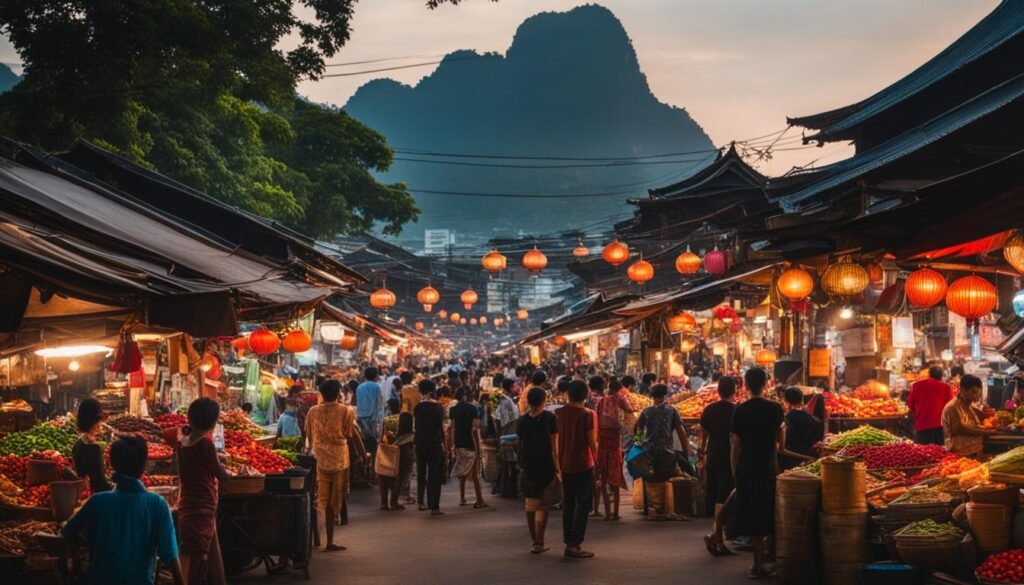Encompassing a diverse range of captivating styles and rich cultural heritage, Traditional Dance south east asia has captured the hearts and minds of dance enthusiasts around the world. With their intricate movements, mesmerizing costumes, and profound stories, southeast asian traditional dance styles hold great significance within the fabric of the region’s history. These southeast asian cultural dances continue to captivate audiences today, blending tradition with modernity and showcasing the vibrant beauty of Southeast Asia’s unique dance traditions. Dive into the world of Southeast Asian traditional dance and discover the enchanting rhythms that have resonated through generations.
Key Takeaways
- The diversity and richness of Southeast Asian traditional dance captivates audiences worldwide
- Historical and cultural influences have shaped these unique dance forms and their stories
- Traditional costumes and instruments play a crucial role in the visual storytelling of each dance
- Festivals and ceremonies across Southeast Asia celebrate and preserve these traditional dances
- Traditional dance in the region continues to evolve, blending with contemporary styles and global influences
The Enchantment of Southeast Asian Dance Traditions
Southeast Asian dance traditions have captivated the world with their intricate movements, fascinating stories, and cultural significance. They offer a rich tapestry of expression, imbued with historical influences, regional diversity, and spiritual elements that make them truly unique. In this section, we uncover the roots and evolution of these cherished dance forms, shedding light on the history, colonialism, and religious aspects that have shaped traditional performances across Southeast Asia.
Defining the Cultural Tapestry
Intrinsically woven with historical, ethnic, and spiritual influences, Southeast Asian dance traditions have an unmatched beauty and complexity. This diversity is a clear reflection of the region’s dynamic history and vibrant soul, wherein each country tells a unique story through its dance forms. The heritage of cultural dances south east asia creates a rich tapestry, with different ethnic groups having their distinct traditional dance forms in asia, as well as shared cultural heritage dances.
- The diversity of southeast asian dance heritage can be traced back to the myriad of indigenous people who have settled across the region.
- Though some dance styles originated from ancient rituals, the influence of religion on southeast asian dances also contributed to the evolution of certain art forms.
- The history of southeast asian dance is intrinsically linked with trading routes, which played a key role in the cultural exchange across the continent.
- Colonial influences further impacted the development and dissemination of various southeast asian dance styles.
Each dance form tells a unique story shaped by the historical, ethnic, and spiritual influences of its region, making Southeast Asian traditional dances a fascinating expression of the region’s rich cultural tapestry.
Understanding Southeast Asian Dance Heritage
In order to appreciate the enchanting world of Southeast Asian dance traditions, one must delve into the background and historical context of these art forms. Studying the history of southeast asian dance and the cultural aspects that fueled their development, provides a profound understanding of the timelessness and significance of these dances today.
| Country | Dance | Origin/Influence |
|---|---|---|
| Indonesia | Wayang Wong Dance Drama | Inspired by ancient Indonesian rituals and shadow puppetry, this dance style embroiders stories from the Ramayana and Mahabharata epics, capturing the influence of Indian culture on Indonesia’s arts. |
| The Philippines | Tinikling | Derived from indigenous war and courtship dances, Tinikling is a testament to the Philippines’ diverse ethnolinguistic groups and their rich cultural heritage. |
| Thailand | Khon | A classical masked dance drama originating from 17th century royal courts, Khon highlights the importance of Hindu mythology and the Ramayana in Thai artistic traditions. |
| Malaysia | Mak Yong | A fusion of ancient animistic beliefs and Islamic mysticism, this traditional dance drama highlights the syncretic nature of Malaysian culture and dance. |
| Vietnam | Hat Boi | Influenced by Chinese and Indian performing arts traditions, this Vietnamese theatrical dance form exemplifies the regional melting pot that is Southeast Asia. |
By exploring the historical roots and cultural influences of Southeast Asian dance traditions, we can better appreciate the enchanting intricacies of these art forms. Each dance embodies the unique vibrancy of a regional culture, while also representing a compelling tapestry of shared experiences, stories, and spiritual connections that span the diverse landscape of Southeast Asia.
Unveiling the Traditional Costumes and Attire
The rich tapestry of traditional Southeast Asian dances is intricately woven with the exquisite traditional dance costumes that narrate the stories, emotions, and essence of these captivating performances. The asian dance costumes are characterized by their diversity, reflecting the region’s vibrant blend of cultural influences. Let us journey through the myriad varieties of southeast asian dance costumes, unraveling their significance, design, and materials.
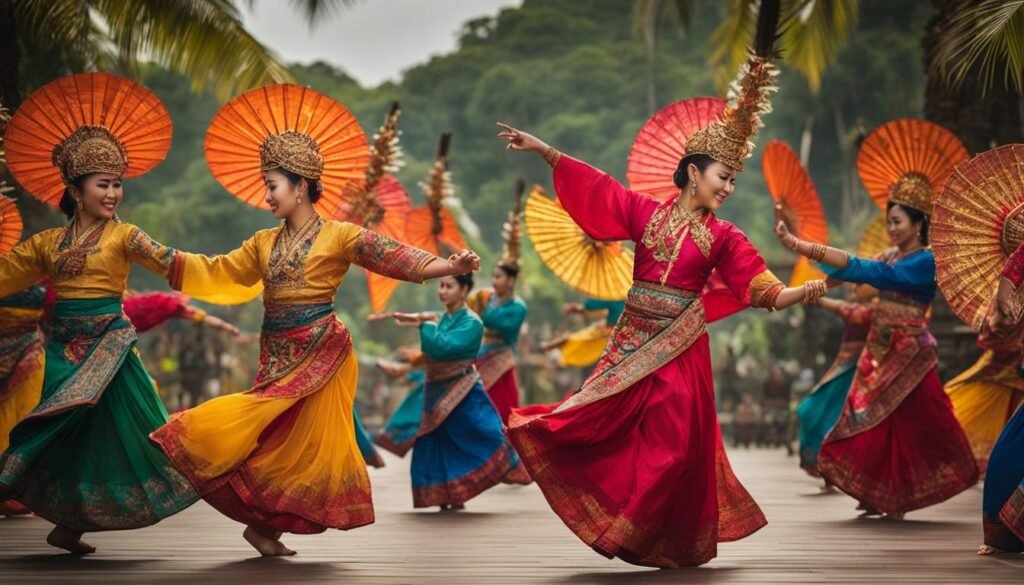
The costumes of Southeast Asian dance vary significantly from one form to another, often representing the social and cultural contexts of each performance. Categories like classical, historical, and folk serve as inspiration for these intricate attires. Here are the crucial elements that comprise most traditional dance costumes:
- Textiles: The choice of fabric contributes significantly to the visual appeal and overall look of the costume. Southeast Asian dancers often don silk, velvet, or cotton, complementing the flow of motion during their performances.
- Color: The use of vibrant colors and patterns in traditional dance attire reflects the region’s rich cultural heritage and artistic nature. Symbolic meanings are often associated with various hues, conveying distinct emotions or themes through the dancers’ garments.
- Accessories: Exquisite adornments such as metallic belts, embroidered scarves, and beaded necklaces enhance the visual impact of the costumes and symbolize the dancers’ roles or status within the performance.
- Headwear: Decorative headpieces are an integral element of traditional dance costumes, signifying cultural significance or character roles in their design and detailing.
Let’s delve into some iconic Southeast Asian dance forms and their captivating costumes:
| Dance Form | Country | Costume Elements |
|---|---|---|
| Apsara Dance | Cambodia | Elaborate gold headdress, silk tunics, and embroidered sashes |
| Barong Dance | Indonesia | Mythical animal masks, fringed silk fabrics, and gold accessories |
| Thai Classical Dance | Thailand | Ornate golden headdresses, bejeweled tunics and accessories, and impressive shoulder extensions |
| Singkil Dance | Philippines | Crown-like headpiece, metallic choker, and colorful traditional malong fabric |
“The costumes are not just garments, but an extension of the dancer embodying the spirit of the characters they portray, as well as the emotions they evoke.”
Through the vibrant and intricate artistry seen in traditional dance costumes, these timeless performances continue to enchant audiences, preserving the cultural heritage and history of Southeast Asia. As we delve deeper into the enchanting world of Southeast Asian dance traditions, these costumes offer a captivating glimpse into the stories and sentiments behind each performance.
Traditional Dance Music of Southeast Asia
Music is a defining element of traditional dance in Southeast Asia, with its unique melodic structures and instrumentation bringing both power and grace to these enthralling performances. This section will explore the captivating sounds and instruments that accompany the region’s dance art forms, providing an insight into the essential role of music in traditional Asian dance presentations.
Instrumentation and Melodic Structures
Southeast Asian dance music is characterized by its varied and distinctive collection of instruments that lend each performance a unique regional flavor. The diverse array of instruments used include percussive ensembles like gamelan in Indonesia, xylophones and gongs in Cambodia, and leather drums in Thailand. Melodic instruments like the bamboo flute, stringed instruments like the lute or the bowed fiddle can also be found, adding layers of harmony and nuance to the overall sound.
When it comes to melodic structures in Southeast Asian music, there are also several regional differences. For example, Indonesian dance music often uses the pentatonic (five-note) scale, whereas Cambodian music focuses on the heptatonic (seven-note) scale. These variations in melodic structure contribute to the rich tapestry that is traditional dance music in the region.
The Role of Music in Dance Performances
Music is integral to dance rituals in Asia, bringing the stories, traditions, and cultural expressions of the region to life. In traditional Asian dance performances, music serves several important functions for both the dancers and the audience:
- Rhythm and Timing: Music provides the rhythmic backbone for the dance, ensuring that the complex movements and intricate choreography are synchronized and precisely timed.
- Mood and Atmosphere: The tones and melodies used in the dance music create the emotional landscape of the performance, evoking a wide range of feelings from joy and celebration to sorrow and reflection.
- Storytelling: Through variations in tempo, dynamics, and instrumentation, music helps to convey the narrative of the dance, emphasizing key moments in the story and guiding the audience through the unfolding drama.
- Ritual and Spiritual Significance: In many Southeast Asian cultures, dance performances are deeply entwined with religious and spiritual beliefs. The accompanying music often serves as a medium for invoking the divine, connecting the human world with the realm of the gods and ancestors.
Overall, music plays a vital role in bringing traditional dance to life, providing aural and emotional depth to the visual spectacle of the performance. The rich textures and evocative sounds of Southeast Asian dance music continue to captivate audiences across the globe, preserving the region’s cultural heritage and showcasing the beauty of its traditional art forms.
Iconic Traditional Dance Forms Across Southeast Asia
Southeast Asia is a region teeming with rich cultural diversity and creativity, which is especially evident in its traditional dances. From classical dance narratives to vibrant folk dances, these captivating performances have been passed down through generations and continue to enchant audiences with their intricate beauty and meaningful stories.
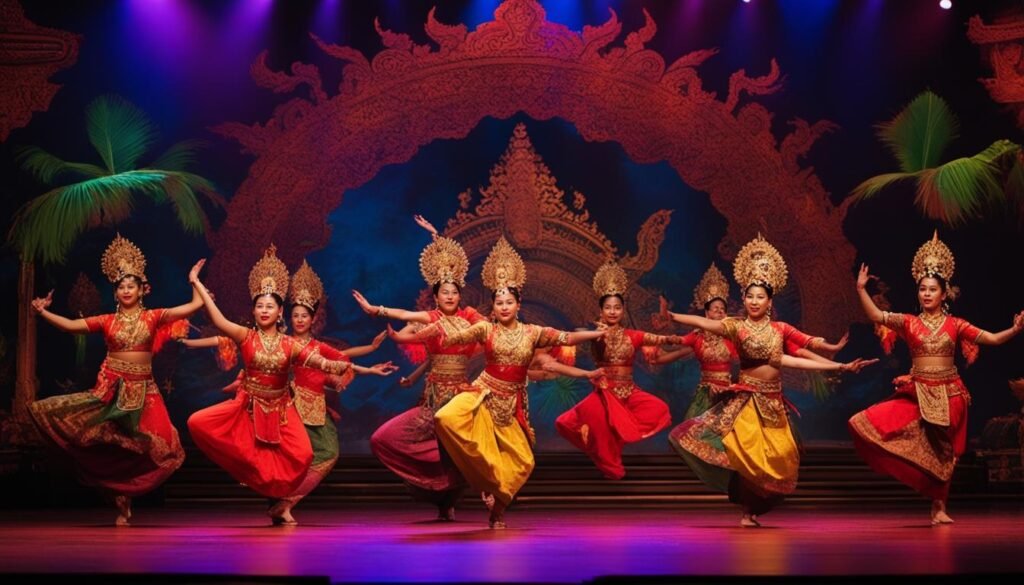
Classical Dance Narratives
The classical dance narratives of Southeast Asia are treasured performances that often recount historical myths or legends. These dances have withstood the test of time, remaining relevant and admired in modern-day culture. The following are some prominent classical dance narratives from various countries in the region:
- Ramayana (Cambodia, Indonesia, Thailand, Malaysia, Brunei, and Laos): A Hindu epic that has been adapted into numerous dance dramas across Southeast Asia, depicting the life and journey of Rama.
- Wayang Wong (Indonesia): A traditional Javanese dance drama that portrays the stories of the Hindu epics Ramayana and Mahabharata.
- Lakorn Nai (Thailand): A classical Thai court dance that is usually accompanied by a verse recitation or narrative song, telling tales of mythology and history.
Indigenous Folk Dances and Their Significance
Indigenous and folk dances of Southeast Asia are reflections of community life, agricultural rituals, and regional practices that have been transmitted through generations. The importance of these dances is showcased in various traditional performances across the region:
| Country | Folk Dance | Significance |
|---|---|---|
| Philippines | Tinikling | Known as the national dance of the Philippines, Tinikling imitates the movements of tikling birds, with dancers hopping between bamboo poles to avoid being trapped. |
| Indonesia | Samon Dance | A traditional dance of the Dayak people of Kalimantan, the Samon dance is performed to give thanks for a bountiful harvest and to implore the gods for their continued blessings. |
| Laos | Phra Lak Phra Lam | Based on the Lao version of the Ramayana, this dance takes center stage during various cultural and religious events, highlighting the country’s close connection to Indian mythology and history. |
| Myanmar | Bamboo Dance | An energetic folk dance where dancers perform intricate steps while their partners rhythmically strike bamboo poles together, celebrating the bamboo’s significance to local communities and livelihoods. |
| Vietnam | Bai Choi | A unique form of traditional performance blending music, poetry, dance, and theater, Bai Choi is a reflection of the cultural life of the central coast of Vietnam and has been recognized by UNESCO as an Intangible Cultural Heritage. |
| Thailand | Rumwong | A communal folk dance, Rumwong is often performed during festivals and celebrations, creating an atmosphere of joy and unity among participants. |
As evident in these various traditions, the folk dances of Southeast Asia serve as powerful expressions of cultural identity and creative spirit. Through continued practice and appreciation, these art forms will thrive and inspire future generations to come.
Festivals and Ceremonies: The Heartbeat of Southeast Asian Dances
Encompassing a diverse range of traditional and contemporary dance styles, dance festivals in Southeast Asia showcase the region’s rich cultural heritage and offer a unique platform for cultural expression and celebration.
From grand classical dance narratives to vibrant folk dances, these festivals provide an avenue for local and international audiences to engage with the performing arts and experience the beauty and cultural significance of southeast asian ceremonial dances. In this section, we will explore some of the notable dance festivals and cultural dance events in Asia that contribute to the preservation and promotion of Southeast Asian dance traditions.
- BaliSpirit Festival, Indonesia
- Water Festival, Myanmar, Cambodia, and Thailand
- Kadayawan Festival, Philippines
- Bun Pi Mai, Laos
- Chingay Parade, Singapore
These festivals and ceremonies foster a sense of unity and belonging among diverse communities in the region, as the audience gathers to enjoy the visual spectacle and exhilarating performances of traditional dance forms. Let’s take a closer look at the significance of these events and their contribution to the preservation of dance heritage in Southeast Asia.
| Festival | Country | Significance |
|---|---|---|
| BaliSpirit Festival | Indonesia | A week-long celebration of yoga, dance, and music, the BaliSpirit Festival showcases traditional Balinese dance performances alongside contemporary world music and dance styles. |
| Water Festival | Myanmar, Cambodia, and Thailand | Marking the traditional New Year in these countries, the Water Festival includes traditional dance performances, boat races, and water splashing to symbolize cleansing and renewal. |
| Kadayawan Festival | Philippines | A week-long thanksgiving celebration that honors the indigenous people of Davao City, Kadayawan Festival showcases the vibrant culture and traditional dance forms of the Philippines. |
| Bun Pi Mai | Laos | The Lao New Year celebration features parades, beauty pageants, and traditional dance performances, highlighting the country’s rich cultural heritage. |
| Chingay Parade | Singapore | An annual street festival held during the Lunar New Year, the Chingay Parade showcases traditional dance performances reflecting Singapore’s diverse cultural heritage. |
“Dance is the hidden language of the soul.” – Martha Graham
In conclusion, the various dance festivals and ceremonies held throughout Southeast Asia play a crucial role in preserving and promoting the region’s diverse dance traditions. By showcasing both traditional and contemporary forms of dance, these cultural dance events in Asia serve as platforms for artistic expression, community bonding, and the celebration of a shared cultural heritage that continues to thrive and evolve.
Southeast Asian Dance And Its Impact on Cultural Identity
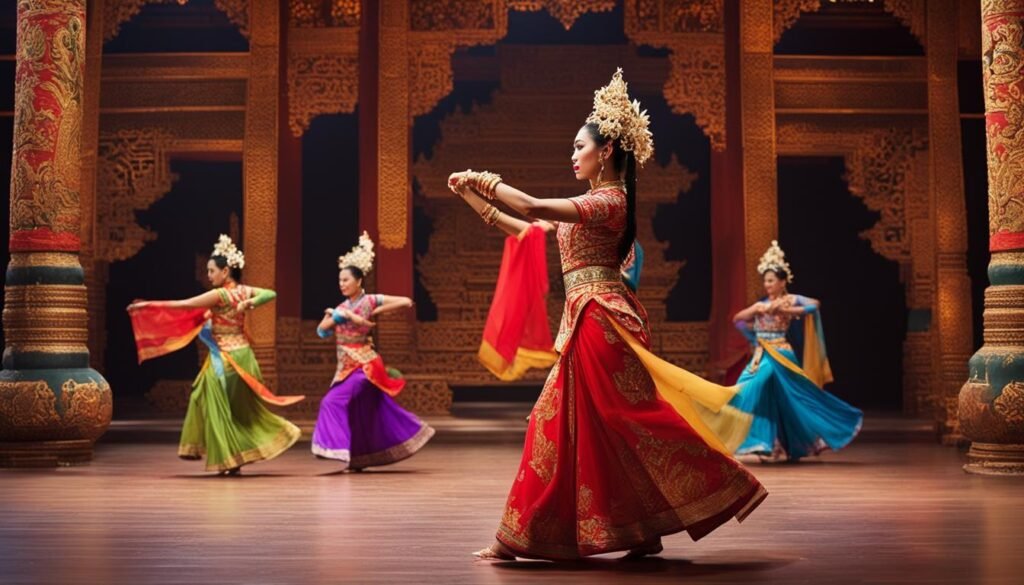
Southeast Asian dance has a deep connection with the various ethnic groups in the region, significantly contributing to the cultural identity of these communities. Dance traditions in Southeast Asia serve to express community and belonging and possess a rich narrative power, both essential to the diverse cultures within the region.
Expression of Community and Belonging
In Southeast Asia, dance is an integral aspect of community life and social cohesion. The traditional regional dances showcase a vibrant expression of identity and unity, weaving together shared histories, values, and aesthetics.
Communities come together through dance performances to celebrate significant occasions, such as religious events, harvest festivals, and other milestones. While each country in the region offers a unique repertoire of traditional dance steps, a common thread throughout Southeast Asia is the emphasis on expression of community through dance. These dance performances not only reflect regional traditions, but also foster a profound sense of belonging among the performers and audiences alike.
Dance as a Means of Storytelling
With roots in ancient rituals and prehistoric practices, dance has long been a significant medium for storytelling in the region. Traditional dance narratives often centre around folklore, mythology, moral tales, and reflections on the human condition. Rich in symbolism and imbued with lessons on life and nature, these dances transmit the philosophical beliefs that underpin life in Southeast Asia.
“Dance performances in Southeast Asia are like a window to the culture’s soul, revealing stories of love, loss, history, and more.”
Some dances, such as the Ramayana Ballet in Indonesia and the Mindanao Kulintang ensemble from the Philippines, combine elegant traditional dance steps with elaborate costumes and set designs, creating an immersive storytelling experience for viewers. This integration of narrative, movement, and visual spectacle showcases the captivating essence of Southeast Asian dance as a vehicle for meaningful cultural stories.
- Indonesia: Wayang Wong Dance – A dramatic reenactment of the epic Ramayana through intricate costumes and dance movements
- Thailand: Khon Dance – A masked dance drama based on the Ramakien, the Thai adaptation of the Hindu epic Ramayana
- Philippines: Singkil Dance – A traditional Maranao dance retelling a tale from the Darangen, a Philippine epic based on the Ramayana
- Malaysia: Mak Yong Dance – A traditional dance and theater form which combines elements of storytelling, dance, and music to present stories of Malay folklore and history
By celebrating and preserving the rich southeast asian dance and identity, communities across the region ensure the intergenerational transmission of these traditional art forms. The continued promotion and protection of these dances are crucial to maintaining the region’s cultural heritage and fostering a sense of unity, community, and belonging in the face of an ever-changing world.
The Evolution of Dance: Blending Traditional with Contemporary
The world of dance is continuously evolving, and Southeast Asia is no exception. The region has seen a fascinating development in dance, crossing boundaries between traditional and contemporary styles. As global influence continues to seep into the culture, the distinction between traditional vs. modern dance in Southeast Asia has become blurred. This exciting blend of old and new pays homage to the rich history and storied traditions while also embracing the innovations and cross-cultural influences that characterize the modern era.

As the evolution of dance in Southeast Asia progressed, contemporary dance styles emerged that incorporated elements from traditional forms while pushing the boundaries of creative expression. This fusion, often influenced by elements from Western dance and other global styles, has given rise to a new generation of artists who celebrate the past while looking towards the future.
The dynamic intersection of cultures, combined with strong traditional roots, sets the stage for an environment where innovation and tradition can coexist and flourish within Southeast Asia’s ever-evolving dance community.
Cross-Cultural Influences in Southeast Asian Dance
One of the driving forces behind the blending of traditional and contemporary dance styles is the impact of cross-cultural influences in Southeast Asian dance. These influences come from diverse sources, such as the increasing exposure to Western dance forms, collaborations with international artists, and the exploration of global diasporas and their relationship to Southeast Asian heritage. In blending these various influences, contemporary dancers and choreographers in Southeast Asia have forged their own unique paths, redefining the region’s dance landscape without abandoning its cultural roots.
- Indigenous Movements and Techniques: Contemporary Southeast Asian dance artists often draw from the wealth of traditional dance styles to create something fresh and unique, incorporating indigenous movements and techniques into their performances.
- Collaborations with Global Artists: Artistic and creative partnerships between Southeast Asian dance artists and their counterparts from other parts of the world have enhanced exchanges of ideas and practices, resulting in innovative and captivating performances.
- Exploration of Global Diasporas: Many contemporary dancers and choreographers in Southeast Asia are exploring the connections between their region and global diasporas, using dance to tell stories of migration, identity, and the shared cultural experience.
In the end, the blending of traditional and contemporary dance styles in Southeast Asia is a testament to the region’s rich and diverse cultural history, as well as its ability to adapt to and incorporate new influences from around the world. By acknowledging and celebrating the past while embracing the future, Southeast Asian dance artists contribute to a vibrant and dynamic artistic landscape that continues to evolve and fascinate audiences both within the region and globally.
Promoting and Preserving Dance: Schools, Training, and Tourism
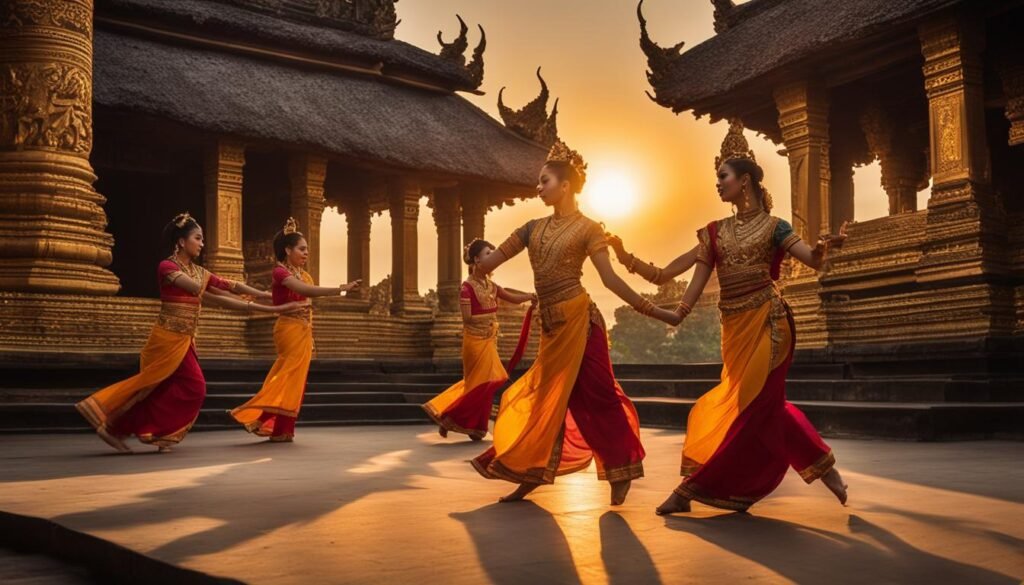
Southeast Asian dance traditions are being preserved and passed down to future generations through a variety of efforts, including the establishment of dance schools and the incorporation of traditional performances into tourism experiences.
Educational Institutions and Their Role in Dance Preservation
Major southeast asian dance schools and organizations are dedicated to providing ethnic dance training in Asia, ensuring the continued practice and appreciation of traditional forms across the region. These schools play a pivotal role in the preservation of traditional dances in Asia, equipping students with not only the technical skills but also the cultural context of each dance tradition.
Notable dance schools and institutions include:
- Ramli Ibrahim’s Sutra Foundation in Malaysia
- Amarta Saraswati Dance Company in Bali, Indonesia
- University of the Philippines Dance Company
- Sanggar Tari Kembang Goyang in Jakarta, Indonesia
These institutions are not only training grounds for future dancers but also serve as repositories and research centers for the documentation and study of Southeast Asian dance heritage.
Dance as an Attraction: Tourist Engagement with Traditional Performances
Dance plays a significant role in southeast asian dance and tourism, as traditional performances have become major attractions for visitors seeking cultural experiences during their travels. As such, dance has helped to stimulate local economies and enhance awareness of the region’s rich dance heritage in southeast asia.
Tourists can engage with traditional performances as part of their excursions, cultural tour packages, or by taking part in dance workshops. The following table highlights popular destinations where traditional dance performances can be found:
| Country | Traditional Dance Forms | Tourist Attraction |
|---|---|---|
| Indonesia | Legong, Barong, Kecak | Ubud Palace, Uluwatu temple |
| Thailand | Khon, Lakhon, Fawn Thai | Sala Chalermkrung Royal Theatre, Siam Niramit |
| Philippines | Tinikling, Singkil, Itik-Itik | Cultural Center of the Philippines, Villarosa’t Salasalan |
In conclusion, the future of traditional dances in Southeast Asia is ensured through dedicated dance schools and cultural institutions that impart both proficiency and understanding to new generations. Meanwhile, tourism provides a platform for these art forms to be appreciated beyond their local communities, fostering global appreciation and support for the preservation of the region’s distinct traditional dance forms across southeast asia.
Embracing the Legacy of Southeast Asian Traditional Dance
As we reach the end of our journey exploring the beauty and significance of traditional dance in Southeast Asia, it’s important to acknowledge the remarkable diversity of styles and cultural heritage dances. From historical narratives to indigenous folk dances, these art forms carry the spirit and essence of Southeast Asian societies and their unique identities. They have stood the test of time and continue to captivate audiences worldwide, serving as a testament to the region’s rich cultural tapestry.
Throughout this exploration, we’ve seen how traditional dance styles have evolved, blending time-honored techniques with contemporary innovations, while maintaining their deep-rooted connections to customs and beliefs. Educational institutions and dance organizations play a pivotal role in preserving these traditions for the coming generations, ensuring that the unique beauty of Southeast Asian dance remains a vibrant part of the global arts landscape.
In conclusion, celebrating traditional dance in Southeast Asia fosters a deeper appreciation of the region’s diverse cultural heritage and identity. As a global community, it is our collective responsibility to support and engage with these art forms, so that they may continue to thrive and inspire future generations. Together, let’s cherish the legacy of Southeast Asian traditional dance and their profound impact on the world of performing arts.
FAQ
What are the main influences on Southeast Asian traditional dance?
Southeast Asian traditional dance is shaped by various factors, including the region’s history, cultural diversity, geographic location, spiritual beliefs, and ethnic identities. Colonialism and religion have also played significant roles in the development of different dance forms.
How important are traditional costumes in Southeast Asian dance performances?
Traditional costumes are an essential aspect of Southeast Asian dance performances, as they help tell the cultural stories being portrayed. The attire, including textiles and accessories, is often symbolic and adds to the visual storytelling in each dance form.
What makes the music unique in Southeast Asian traditional dance?
Southeast Asian traditional dance music is characterized by its unique sounds, regional variations in melodic structures, and the wide range of instruments used in ensembles accompanying the dancers. This music also plays a vital role in creating a complete performance experience and serves as a foundation for storytelling through rhythm and harmony.
What are some examples of classical and indigenous dance forms in Southeast Asia?
Some renowned classical dance forms in Southeast Asia include the Cambodian Apsara dance, Thai Khon, and Indonesian Legong. Indigenous and folk dance forms, such as the Moro Iglesia in the Philippines and the Tari Piring in Indonesia, often reflect community life, agricultural rituals, and regional practices passed down through generations.
How do festivals and ceremonies contribute to the preservation of Southeast Asian dance traditions?
Festivals and ceremonies provide a platform for cultural expression and collective celebration, allowing traditional dance forms to remain an integral part of Southeast Asian culture. These events showcase vibrant performances and serve as a crucial avenue for the practice and preservation of traditional dance styles in the region.
How does dance contribute to the cultural identity in Southeast Asia?
Dance plays a significant role in fostering a sense of community and belonging, solidifying ethnic identities, and expressing the diverse cultures of Southeast Asia. It also serves as a means of storytelling, conveying folklore, moral tales, and philosophical beliefs integral to the region’s cultural identity.
What is the relationship between traditional and contemporary dance in Southeast Asia?
The relationship between traditional and contemporary dance in Southeast Asia is dynamic and constantly evolving. Many modern choreographies respect historical roots while embracing global influences and innovative approaches, creating a unique blend of old and new styles.
How are dance schools and organizations helping to preserve traditional dance forms?
Dance schools and organizations are instrumental in training new generations in the technical and cultural aspects of traditional dance, ensuring its longevity and perpetuation. They play a vital role in promoting and preserving these rich dance traditions for future generations.
What is the role of dance in Southeast Asian tourism?
Dance plays a crucial role in Southeast Asian tourism, as traditional performances have become major attractions for visitors looking to immerse themselves in local cultures. Showcasing traditional dance styles helps strengthen the region’s cultural identity and creates opportunities for engagement and support to preserve these traditions.


